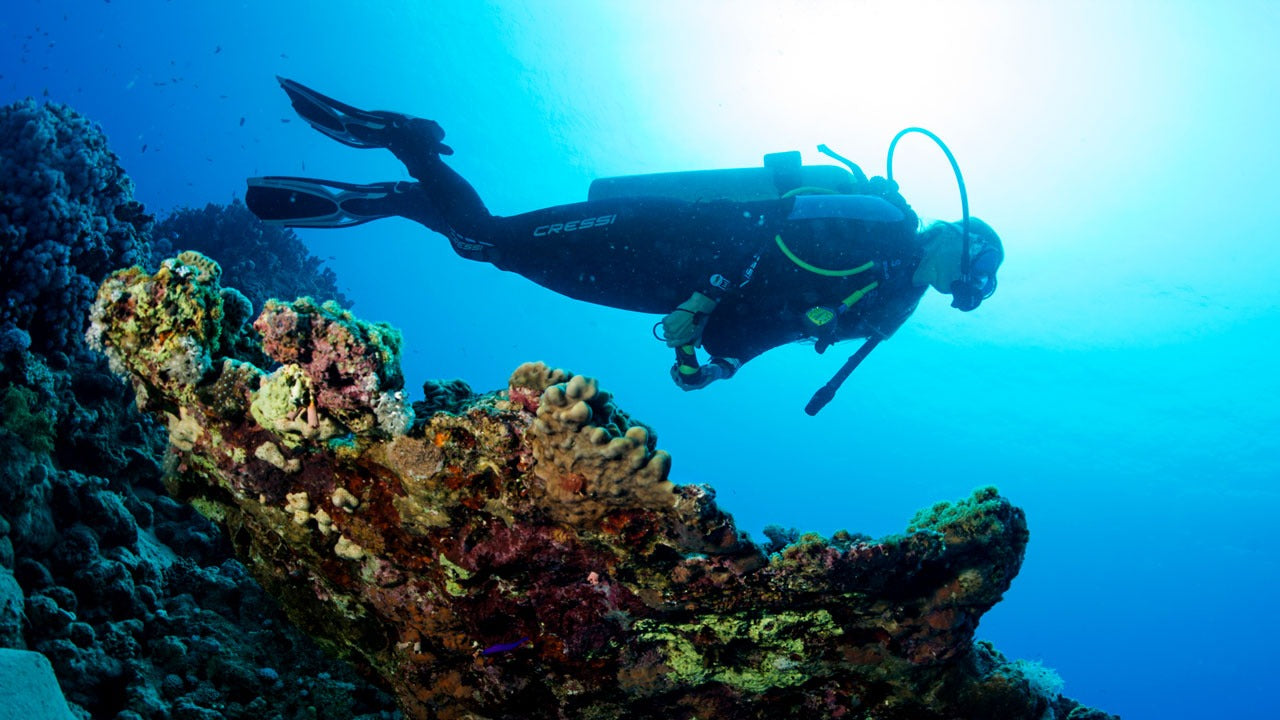7 Common Scuba Diving Myths And the Truth Behind Them

Scuba diving is an amazing activity that can help you discover the magical realm below the surface. While more and more people are becoming interested in diving, this sport is still surrounded by numerous misunderstandings and even plain-old myths. Unfortunately, those, who have succumbed to these misconceptions are likely to never try their hand at scuba diving. What’s more, even some well-educated divers believe and pass these untruths on to others. Therefore, we have decided to look at some of the most common myths about diving safety, physiology, marine life, etc., and reveal the truth behind them.
Myth #1 You have to be an expert swimmer to become a diver
Truth: This myth is probably one of the chief reasons most people are hesitant to try scuba diving. Apparently, it has originated from the fact that each diver needs to pass a basic swim test at the start of scuba lessons, namely swim about 200 yards nonstop. Even though the distance may seem large, there is no time limit and the diver may use any stroke he/she is comfortable with. The goal of the test is to check whether you have basic water skills and will be able to swim yourself to safety in case of an emergency. Evidently, you don’t have to be an Olympic-level swimmer to pass this brutal test of physical ability.
That said, diving is an active sport, so the better shape you're in, the easier and more enjoyable it will be for you to participate in this pastime. Try to stay healthy and maintain at least an average fitness level to get the most of scuba.
Myth #2 You have to buy a lot of expensive gear just to start learning
Truth: Indeed, scuba diving is an equipment-intensive sport, but you don’t have to buy any of the gear to start the lessons. Most dive shops provide loaners for their students during the course. Nevertheless, the majority of divers prefer to have their own mask, snorkel, and fins. These basic items are quite personal and need to fit well for you to feel comfortable underwater. What’s more, they are very inexpensive and can be upgraded as funds allow. As for the rest of the gear, you can continue to use rental services, until you decide that you are serious enough about diving to purchase your own set.
Myth #3 You need to travel to exotic tropical locations in order to dive
Truth: Sure, diving in warm, clear tropical waters is great, but so is drifting in Niagara River, exploring the magnificent shipwrecks in Lake Michigan or Huron, enjoying the Florida Keys or conquering the depths of many other lakes, rivers, and quarries. As a matter of fact, there are some great dive sites in most if not all states. You can simply visit your local dive shop or get in touch with the scuba community to learn about the best places to dive in your area. Just remember, diving in different bodies of water means that you will have to adjust to different environments and temperatures, thus make sure you are properly trained and have all the necessary gear.
Myth #4 You have to dive very deep to see anything interesting
Truth: While some divers like the adrenaline in their blood and enjoy the challenge of pushing the limits, most people go into recreational diving to see the marine flora and fauna as well as explore sunken structures. Even very experienced divers admit that their best dives were at about 35-50 feet (10-15 meters) deep. Want some more compelling evidence? Researchers have discovered that around 90% of marine life is found in shallow water near coastlines. So if you want to enjoy the beauty of vibrant reefs and colorful shoals of fish, there is no need to descend into the abysmal depths.
Myth #5 Sharks are a major threat to divers
Truth: Even though movies like Jaws, Jaws 2 and other popular media have done a pretty good job at persuading the public that sharks are bloodthirsty monsters lurking beneath the surface of every body of water and waiting to munch on divers, in reality, things are quite different. First of all, shark encounters are very rare (unless you are going on a specific shark dive) and are considered to be a privilege. Secondly, in total there are more than 400 different species of sharks, and most of them will shy away from divers. Sure, there are exceptions, but if you take precautions, such as keeping your hands to yourself, staying neutrally buoyant, and not agitating the animal purposefully, the risk of the attack will be minuscule. Finally, according to statistics, shark attacks kill less than one person annually, while champagne corks take out 24 of us every year and falling coconuts attribute to as many as 150 deaths yearly. Unexpected, huh?
Myth #6 You will get lost underwater and the dive boat will leave without you (at this point the sharks will obviously get you)
Truth: Just like the myth about sharks, this scary tale has been fueled by the movie industry and is very unlikely to happen in reality. One of the first things you need to do when preparing for the dive is to choose a dive buddy. You and your buddy will work together to orient yourselves and generally look out for one another. What’s more, novice divers usually dive with a guide or in a group, this way they can be sure that they will never get lost. Lastly, the boat crew always does a headcount before and after each dive. Evidently, the chances of being left behind in the middle of the ocean are pretty slim. Nevertheless, you should always pick a quality dive operator and carry a Personal Location Beacon.
Myth #7 You guide/instructor/buddy is responsible for your safety
Truth: While it is true, that you and your dive buddy or guide are supposed to help each other and look out for each other, subsequently, you are the one responsible for your own safety. It is important for you to be a self-sufficient, skilled and sensible diver. It’s amazing how often divers follow their guides or more experienced companions without even asking such simple questions as where they are going or how long they plan to stay. Before going into the water, make sure you have done proper dive planning, discussed it with your buddy and know your dive objective, time, emergency procedures, etc. Once again, in most cases your fellow divers, guides and boat crew will do everything to keep all divers out of danger and comfortable, however, the ultimate responsibility for your own safety is on you.




